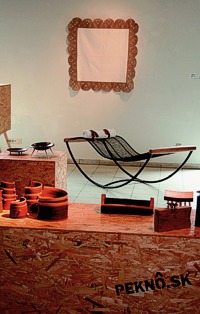Viera Kleinová
The travelling exhibition project of Slovak crafts and design, peknô.sk, [pekno means nice or pretty in old-fashioned folk Slovak] was created based on the request of a long-term ÚĽUV partner – the Finnish organization Taito Group. The exhibition cycle was opened on September 6 in Tamper, and it will continually travel to other Finnish cities.
The exhibition is designed as a view of Slovak art, craft and utilitarian creation with an emphasis on connecting domestic traditional culture. The exhibition contains the works of Slovak craftsmen, designers and artists who use original domestic resources, are interested in folk culture, work with natural materials and classic technologies or perceive tradition as one of the moments of their philosophy and thinking potential. The exhibition includes a wide variety of works from the field of product design, the creation of objects for private interior starting with small table setting elements up to furniture as well as jewel and fashion. More than 45 artists participated in this exhibition – from renowned designers and experienced craftsmen up to the youngest generation represented by students from secondary schools and universities focused on crafts and design.
The name of the exhibition is borrowed from the central Slovak dialect. It is also fine-sounding archaic word. It is not only an implication to the aesthetic qualities of the presented works but also illustrates originality, authenticity and the tie between the historical and the present, the intuitive connection that unites past and contemporary creators.
The exhibition united the traditional conservative craft with extravagant, non-conform design and utilitarian art. It embraced designs that were created in the past but are still topical as well as newer completely innovative implementations. Peknô.sk is not only about things and products but also about the context in which they were developing, changing, forming, existed or still exist. Also, therefore, the time span between the oldest and youngest object in the exhibition is more than 50 years. In a certain way, the exhibition is a short get-to-know journey through the Slovak craft field.
